The Marine Propulsion Engine Market is estimated to be valued at USD 38.7 billion in 2025 and is projected to reach USD 49.7 billion by 2035, registering a compound annual growth rate (CAGR) of 2.5% over the forecast period.
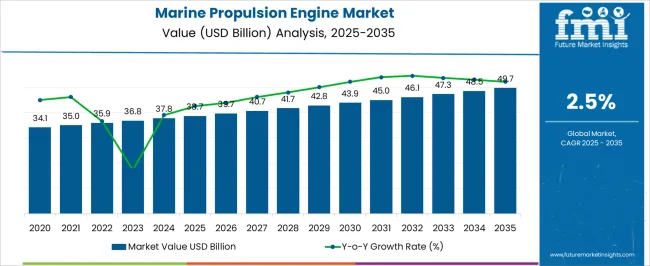
| Metric | Value |
|---|---|
| Marine Propulsion Engine Market Estimated Value in (2025 E) | USD 38.7 billion |
| Marine Propulsion Engine Market Forecast Value in (2035 F) | USD 49.7 billion |
| Forecast CAGR (2025 to 2035) | 2.5% |
The Marine Propulsion Engine market is experiencing robust growth, driven by the increasing demand for efficient and reliable marine vessels across commercial, passenger, and cargo transport sectors. Rising global trade, expanding cruise and ferry operations, and growing investments in port infrastructure are fueling the need for advanced propulsion systems. The market is further supported by regulatory pressures to reduce emissions and improve fuel efficiency, leading to the adoption of high-performance diesel and alternative fuel engines.
Continuous advancements in engine design, automation, and integration with onboard monitoring systems are enhancing operational reliability and reducing lifecycle costs. The growing trend toward sustainable and energy-efficient vessels is driving demand for engines that comply with international maritime regulations.
Additionally, the focus on minimizing operational downtime and maintenance costs is reinforcing adoption of technologically advanced propulsion solutions As shipping companies and vessel operators prioritize efficiency, reliability, and environmental compliance, the Marine Propulsion Engine market is positioned for sustained expansion over the coming decade, supported by innovation in engine technology and fuel optimization.
The marine propulsion engine market is segmented by engine type, application, ship type, fuel type, power range (kw), and geographic regions. By engine type, marine propulsion engine market is divided into Diesel, Dual-Fuel (Lng, Methanol, Ammonia Ready), Gas Turbine, Hybrid-Electric, Fuel-Cell, and Nuclear (Naval). In terms of application, marine propulsion engine market is classified into Passenger, Commercial Cargo, and Defense / Coast Guard. Based on ship type, marine propulsion engine market is segmented into Container Ship, Tanker, Bulk Carrier, Offshore Support Vessel, Naval Ship, and Passenger / Cruise. By fuel type, marine propulsion engine market is segmented into Heavy Fuel Oil (HFO), Marine Diesel/Gas Oil, LNG, Methanol, and Ammonia/Hydrogen. By power range (kw), marine propulsion engine market is segmented into Up To 1 000 kW, 1 001 kW To 5 000 kW, 5 001 kW To 10 000 kW, 10 001 kW To 20 000 kW, and Above 20 000 kW. Regionally, the marine propulsion engine industry is classified into North America, Latin America, Western Europe, Eastern Europe, Balkan & Baltic Countries, Russia & Belarus, Central Asia, East Asia, South Asia & Pacific, and the Middle East & Africa.
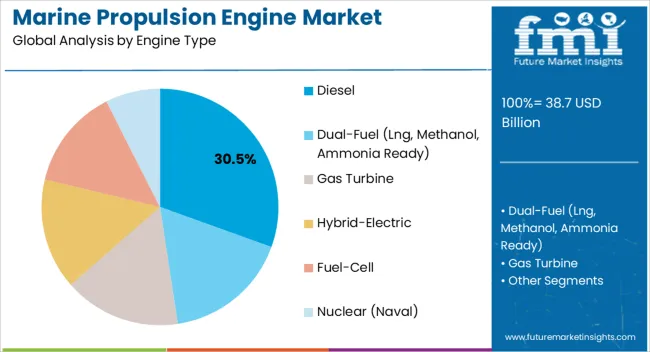
The diesel engine segment is projected to hold 30.5% of the Marine Propulsion Engine market revenue in 2025, establishing it as the leading engine type. Growth in this segment is being driven by diesel engines’ high reliability, fuel efficiency, and adaptability across a variety of marine vessels, including commercial ships and passenger ferries. Diesel engines provide robust performance for long-distance navigation and heavy-duty operations, making them the preferred choice among shipping companies.
Continuous improvements in engine design, emission control technologies, and fuel optimization have enhanced performance while complying with environmental regulations. The integration of monitoring and automation systems allows for real-time performance tracking and predictive maintenance, reducing operational risks.
Rising global trade, expanding container shipping fleets, and increasing passenger vessel operations are further supporting adoption As operators focus on maximizing efficiency and minimizing operating costs, diesel engines are expected to maintain their market leadership, supported by technological advancements, regulatory compliance, and widespread operational experience across maritime applications.
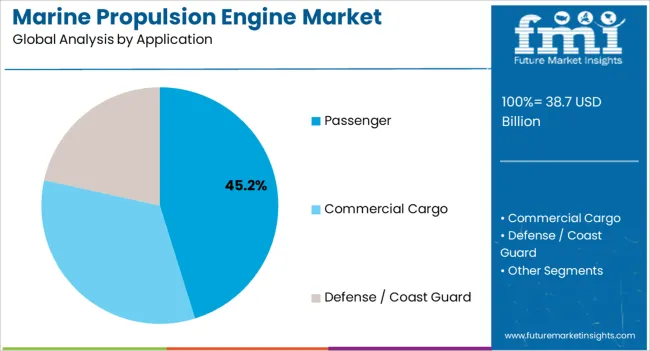
The passenger application segment is anticipated to account for 45.2% of the market revenue in 2025, making it the leading application category. Growth in this segment is being driven by the rising demand for cruise ships, ferries, and other passenger vessels for domestic and international transport. Propulsion engines in passenger vessels are required to deliver high reliability, smooth performance, and fuel efficiency while ensuring passenger safety and comfort.
Advanced engine systems enable real-time monitoring, predictive maintenance, and integration with ship management platforms, improving operational efficiency. Regulatory standards concerning emissions, noise reduction, and safety compliance further reinforce the adoption of technologically advanced engines in passenger ships.
Increasing tourism activities, urban waterway transport expansion, and fleet modernization programs have contributed to higher engine demand As operators seek to improve efficiency, reduce environmental impact, and enhance service reliability, passenger vessels are expected to remain the dominant application for marine propulsion engines, driving overall market growth and technology adoption in the sector.
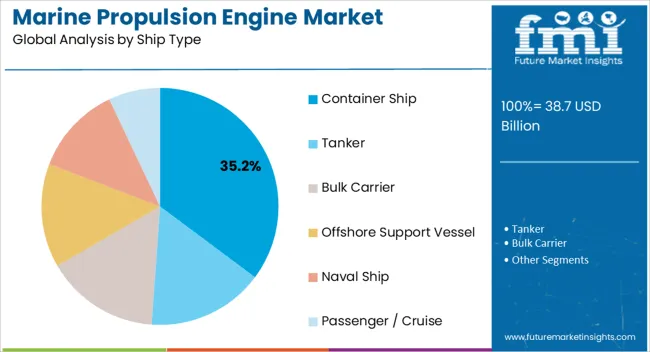
The container ship type segment is projected to hold 35.2% of the market revenue in 2025, establishing it as the leading ship type category. Growth in this segment is being driven by the continuous expansion of global trade, e-commerce logistics, and containerized cargo transport. Marine propulsion engines in container ships are required to deliver high power, fuel efficiency, and operational reliability for long-distance maritime operations.
Advances in engine design, fuel management systems, and emission reduction technologies have enhanced performance while complying with environmental regulations and minimizing operating costs. Container ship operators are increasingly integrating propulsion systems with onboard monitoring and predictive maintenance platforms, ensuring consistent performance and reduced downtime.
The rising number of container vessels, fleet modernization initiatives, and global port expansion projects are further boosting engine demand As shipping companies prioritize operational efficiency, cost-effectiveness, and environmental compliance, container ships are expected to remain the largest ship type driving growth in the Marine Propulsion Engine market.
Marine propulsion is the system or mechanism used to generate thrust that allows a small boat or even a ship to move across waterways. Modern ships are usually equipped with mechanical systems consisting of an electric motor turning a propeller, or even pump-jets or an impeller.
These ships employ reciprocating engines as their main source of power because of their robustness, operational simplicity and lower emissions. The power required by a ship largely depends on the way it is used during regular operations – for e.g. - A passenger ship requires less power than either a trade or naval ship. The marine propulsion engine market serves offshore support vessels, commercial vessels, inland waterway vessels, submarines and more.
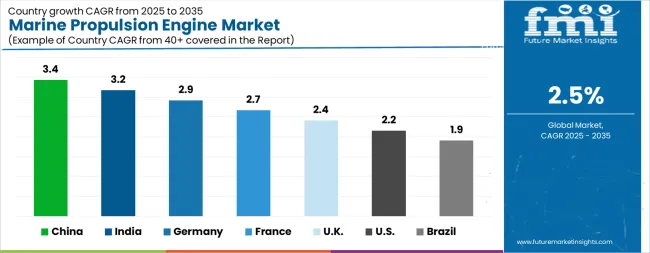
| Country | CAGR |
|---|---|
| China | 3.4% |
| India | 3.2% |
| Germany | 2.9% |
| France | 2.7% |
| UK | 2.4% |
| USA | 2.2% |
| Brazil | 1.9% |
The Marine Propulsion Engine Market is expected to register a CAGR of 2.5% during the forecast period, exhibiting varied country level momentum. China leads with the highest CAGR of 3.4%, followed by India at 3.2%. Developed markets such as Germany, France, and the UK continue to expand steadily, while the USA is likely to grow at consistent rates. Brazil posts the lowest CAGR at 1.9%, yet still underscores a broadly positive trajectory for the global Marine Propulsion Engine Market. In 2024, Germany held a dominant revenue in the Western Europe market and is expected to grow with a CAGR of 2.9%. The USA Marine Propulsion Engine Market is estimated to be valued at USD 14.6 billion in 2025 and is anticipated to reach a valuation of USD 18.0 billion by 2035. Sales are projected to rise at a CAGR of 2.2% over the forecast period between 2025 and 2035. While Japan and South Korea markets are estimated to be valued at USD 1.9 billion and USD 1.3 billion respectively in 2025.
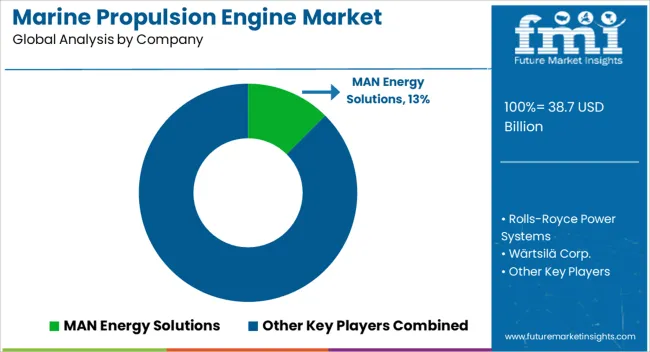
| Item | Value |
|---|---|
| Quantitative Units | USD 38.7 Billion |
| Engine Type | Diesel, Dual-Fuel (Lng, Methanol, Ammonia Ready), Gas Turbine, Hybrid-Electric, Fuel-Cell, and Nuclear (Naval) |
| Application | Passenger, Commercial Cargo, and Defense / Coast Guard |
| Ship Type | Container Ship, Tanker, Bulk Carrier, Offshore Support Vessel, Naval Ship, and Passenger / Cruise |
| Fuel Type | Heavy Fuel Oil (HFO), Marine Diesel/Gas Oil, LNG, Methanol, and Ammonia/Hydrogen |
| Power Range (kW) | Up To 1 000 kW, 1 001 kW To 5 000 kW, 5 001 kW To 10 000 kW, 10 001 kW To 20 000 kW, and Above 20 000 kW |
| Regions Covered | North America, Europe, Asia-Pacific, Latin America, Middle East & Africa |
| Country Covered | United States, Canada, Germany, France, United Kingdom, China, Japan, India, Brazil, South Africa |
| Key Companies Profiled | MAN Energy Solutions, Rolls-Royce Power Systems, Wärtsilä Corp., Caterpillar Inc., Hyundai Heavy Industries Engine & Machinery, Cummins Inc., Mitsubishi Heavy Industries Marine Machinery, Daihatsu Diesel, Yanmar Co., GE Marine, Kawasaki Heavy Industries, Volvo Penta, ABB Turbocharging & Motion, and Siemens Energy Marine |
The global marine propulsion engine market is estimated to be valued at USD 38.7 billion in 2025.
The market size for the marine propulsion engine market is projected to reach USD 49.7 billion by 2035.
The marine propulsion engine market is expected to grow at a 2.5% CAGR between 2025 and 2035.
The key product types in marine propulsion engine market are diesel, dual-fuel (lng, methanol, ammonia ready), gas turbine, hybrid-electric, fuel-cell and nuclear (naval).
In terms of application, passenger segment to command 45.2% share in the marine propulsion engine market in 2025.






Our Research Products

The "Full Research Suite" delivers actionable market intel, deep dives on markets or technologies, so clients act faster, cut risk, and unlock growth.

The Leaderboard benchmarks and ranks top vendors, classifying them as Established Leaders, Leading Challengers, or Disruptors & Challengers.

Locates where complements amplify value and substitutes erode it, forecasting net impact by horizon

We deliver granular, decision-grade intel: market sizing, 5-year forecasts, pricing, adoption, usage, revenue, and operational KPIs—plus competitor tracking, regulation, and value chains—across 60 countries broadly.

Spot the shifts before they hit your P&L. We track inflection points, adoption curves, pricing moves, and ecosystem plays to show where demand is heading, why it is changing, and what to do next across high-growth markets and disruptive tech

Real-time reads of user behavior. We track shifting priorities, perceptions of today’s and next-gen services, and provider experience, then pace how fast tech moves from trial to adoption, blending buyer, consumer, and channel inputs with social signals (#WhySwitch, #UX).

Partner with our analyst team to build a custom report designed around your business priorities. From analysing market trends to assessing competitors or crafting bespoke datasets, we tailor insights to your needs.
Supplier Intelligence
Discovery & Profiling
Capacity & Footprint
Performance & Risk
Compliance & Governance
Commercial Readiness
Who Supplies Whom
Scorecards & Shortlists
Playbooks & Docs
Category Intelligence
Definition & Scope
Demand & Use Cases
Cost Drivers
Market Structure
Supply Chain Map
Trade & Policy
Operating Norms
Deliverables
Buyer Intelligence
Account Basics
Spend & Scope
Procurement Model
Vendor Requirements
Terms & Policies
Entry Strategy
Pain Points & Triggers
Outputs
Pricing Analysis
Benchmarks
Trends
Should-Cost
Indexation
Landed Cost
Commercial Terms
Deliverables
Brand Analysis
Positioning & Value Prop
Share & Presence
Customer Evidence
Go-to-Market
Digital & Reputation
Compliance & Trust
KPIs & Gaps
Outputs
Full Research Suite comprises of:
Market outlook & trends analysis
Interviews & case studies
Strategic recommendations
Vendor profiles & capabilities analysis
5-year forecasts
8 regions and 60+ country-level data splits
Market segment data splits
12 months of continuous data updates
DELIVERED AS:
PDF EXCEL ONLINE
Marine Engines Market Size and Share Forecast Outlook 2025 to 2035
Marine Engine Cooling Systems Market
Marine Propulsion Systems Market
Marine Diesel Engine Market Size and Share Forecast Outlook 2025 to 2035
Marine Outboard Engines Market Size and Share Forecast Outlook 2025 to 2035
Small Marine Engine Market Forecast Outlook 2025 to 2035
Marine Reciprocating Engine Market Size and Share Forecast Outlook 2025 to 2035
Engineering Machinery Counterweight Iron Market Size and Share Forecast Outlook 2025 to 2035
Engine-Driven Endodontic File Market Size and Share Forecast Outlook 2025 to 2035
Marine Nanocoating Market Size and Share Forecast Outlook 2025 to 2035
Marine-grade Polyurethane Market Size and Share Forecast Outlook 2025 to 2035
Marine Electronics Market Size and Share Forecast Outlook 2025 to 2035
Marine Toxin Market Size and Share Forecast and Outlook 2025 to 2035
Marine Thermal Fluid Heaters Market Size and Share Forecast Outlook 2025 to 2035
Marine Nutraceutical Market Size and Share Forecast Outlook 2025 to 2035
Marine Power Battery System Market Size and Share Forecast Outlook 2025 to 2035
Engine Fixture Market Size and Share Forecast Outlook 2025 to 2035
Engine Piston Ring Set Market Size and Share Forecast Outlook 2025 to 2035
Marine Life Raft Market Size and Share Forecast Outlook 2025 to 2035
Engine Cylinder Liners Market Size and Share Forecast Outlook 2025 to 2035

Thank you!
You will receive an email from our Business Development Manager. Please be sure to check your SPAM/JUNK folder too.
Chat With
MaRIA